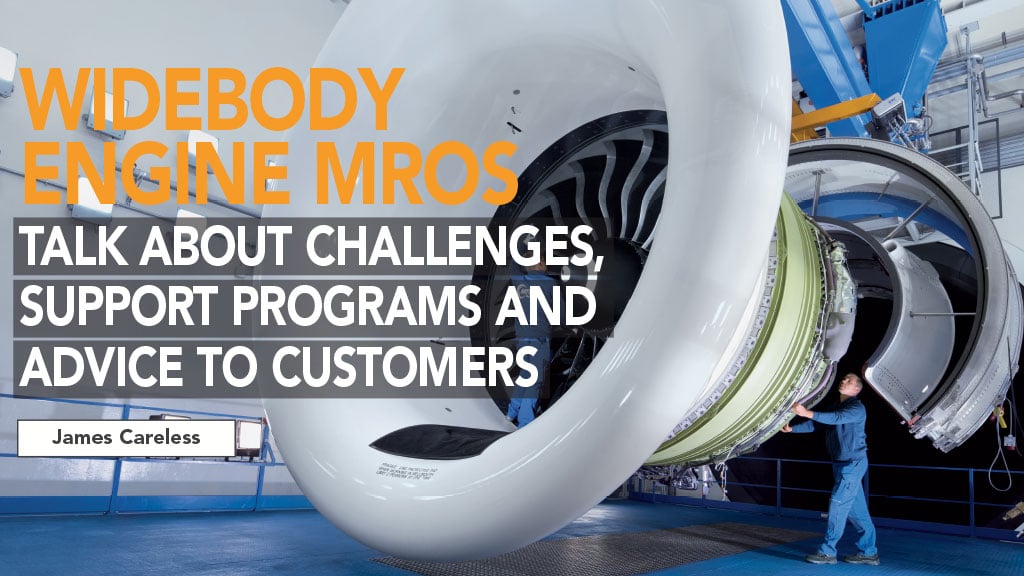Widebody aircraft engines are the heavyweights of aerospace propulsion. As such, they require special care and attention to ensure their reliability and peak performance, making widebody engines expensive items to maintain and replace.
To get an inside look at the world of widebody engines and how owners can optimize their shop visits, Aviation Maintenance spoke with top MROs around the world. In this article, they talk about the challenges associated with maintaining these power plants and the ways in which owners can mitigate their servicing and replacement costs. Some of these MROs even provide advice on how to get the most out of widebody engine shop visits.
AAR
AAR maintains and services widebody jet engines in its MRO network performing engine inspections, LRU and line maintenance, repair and overhaul activities. The company is not in te core engine overhaul business as this is the market occupied by many of its customers. Instead, AAR contracts with its network of engine overhaul customer shops to provide complete solutions to this MRO’s commercial and defense clients.

“For widebody aircraft we have tailored repair and management solutions on the PW4000 /CF6 -80 (MD11/ B747/ B767) & RB211-535 (B757) engine variants,” said Carl Glover, AAR’s VP Sales & Marketing Americas.“ Under these solutions AAR repairs and overhauls the engine accessories in our component MRO network or those of our OEM channel partners. Our partner engine shops perform the engine maintenance with AAR as the USM (Used Serviceable Material) provider.”
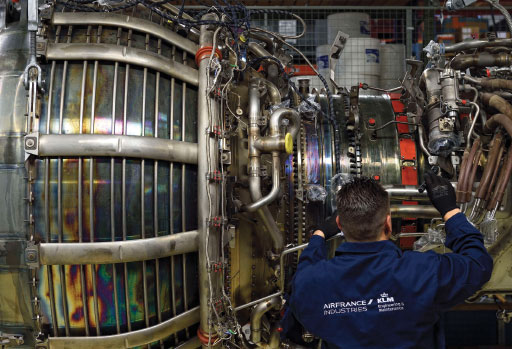
AAR has recently diversified into the support and provision of engine modules for customers which are tailored to their specific build specs, reducing TAT (turn-around times) and EHM (engine heavy maintenance) costs. “When it comes to serving the owners of widebody aircraft, “there are some unique challenges in maintaining some of the widebody engines that are currently being operated,” Glover observed. “Recently there have been some key material shortages in the supply chain affecting component availability. This has impacted shop TAT and driven up demand for certain spare engine types for short term leasing support.”
To mitigate this situation that has been exacerbated by the global pandemic, AAR has been consulting its customers to forecast their future needs for specific widebody engine materials and parts. Doing so is helping the company anticipate and remedy possible shortages, using tactics such as pre-provisioning high repair TAT components in a ‘closed pool’ reserve.
Even with these preemptive measures, “issues remain in the component repair space on some key gas path components due to scrap rates and shop capacity considerations as the vendor community balances capacity to cover the ‘post covid recovery curve,” said Glover. “An additional challenge has been the freight charges for whole engine shipments, which have increased globally due to the demand for main deck freight in response to COVID-19 medical support activities and increased demands from e-commerce.”
To help manage the costs of widebody engine maintenance, AAR provides extensive material management and (SLB) sale leaseback solutions to their engine customers. They also offer large scale engine management programs directly to operators and lessors alike, in which AAR’s technical teams manage engine workscopes, material management and repair activities on their behalf.
As well, “we provide our customers whole engine and module exchanges to increase engine availability,” Glover said. “This has seen particular interest from our widebody freight clients who need operational capacity to support fleet demands. In these instances, AAR supplies them with a serviceable engine/modules while purchasing the unserviceable engine asset from the customer and having them repaired.”
“AAR has been focused on the recovery of the industry in support of our customers in our MRO facilities, component shops and engine business,” he concluded. “We work very close with our customers to ensure we have the capacity, inventory or a workable solution that they may need for engine maintenance and overhauls.”
AFI KLM E&M
AFI KLM E&M’s MRO facilities in Amsterdam-Schiphol, Paris-Charles de Gaulle and Paris-Orly overhaul a wide range of engines fitted on Air France’s and KLM’s aircraft, plus Airbus and Boeing aircraft owned by other carriers. “As an Airline-MRO, we believe our intimate knowledge of not only maintaining but also flying these aircraft and engines is the real difference maker in terms of our ability to closely match the maintenance program with the operational needs of the operator,” said Michael Grootenboer, AFI KLM E&M Senior Vice President of Group Engines Products.
Given this varied client base, AFI KLM E&M works on a range widebody engines. They include the GE90-94 and GE90-115 (Boeing 777) in Paris, with the Trent-XWB (Airbus A350) soon to be supported there as well. In Amsterdam, the company services the GEnx-1B (Boeing 787), the CF6-80E (Airbus A330) and the CF6-80C2 (various aircraft such as the 747.)
In addition, AFI KLM E&M’s global network allows the company to offer other services such as widebody engine parts repairs, teardowns and others. “As an example, with our joint venture in Miami with Bonus Tech, we provide teardown solutions for a wide range of engine types, including the PW4000, Grootenboer said. “Through Airfoils Advanced Solutions, our joint venture in Rosult, France we perform High Pressure Combuster airfoil repairs on engines such as the GE90. And both in our engine shop in Amsterdam and at our subsidiary CRMA in Elancourt (just outside Paris), we offer a wide range of parts repairs for our full engine range, including CF6, GEnx, GE90 and GP7200 on parts such as the combustor and the fan mid shaft.”
As with other widebody engine MROs, the pandemic confronted AFI KLM E&M with challenges such as supply chain shortages/delays and unpredictable customer demand. In particular, “the COVID-19 crisis required us to adapt our maintenance operations to the lower operating pace of our parent airlines and customers’ fleets,” said Grootenboer. “So we streamlined our production and accelerated improvement projects we had already launched on the shop floor, as well as customer solutions such as Smart Work Scoping and Remote Table Inspection. We were aided in this by the inherent flexibility of our organization and our highly skilled workforce.”
Now that COVID-19 is waning, AFI KLM E&M is managing the usual issues associated with widebody engine maintenance. “The more EGT-driven nature of widebody engine maintenance programs, when compared to the generally cycle-limit driven programs on narrow body engines, requires a different strategy in monitoring the operational engine and planning its maintenance,” Grootenboer noted. “Here we are greatly aided by our own Prognos for Engines predictive maintenance solution.”
“Furthermore, widebody engines are of course significantly more costly than narrow body engines, while its numbers operating worldwide are generally smaller,” he continued. “This results in a different trade-off when it comes to developing and/or industrializing repairs for the engine’s parts. Our in-house capability for the repair of, for example, combustors and fan mid shafts for GE90 and GEnx gives us a significant cost advantage, while making us less reliant on the (occasionally disrupted) supply chain. Equally importantly, repair and reuse of engine parts lowers not only the cost of ownership, but reduces the consumption of resources and energy for the manufacture of new parts and thereby contributes to the sustainability of the maintenance and operation of aircraft engines.”
The current economic climate has made it more difficult for widebody aircraft operators to pay for repairs and overhauls. In response to this reality, AFI KLM E&M offers a range of payment plans and of comprehensive maintenance solutions to fit the needs and budget of the operators. These apply to items such as providing or sourcing spares, leveraging the range of AFI KLM E&M’s material solutions (new, repaired and used serviceable parts) to optimize shop visit cost, offering smart workscoping to create a custom visit that fits the needs and budget of customers, and working with this MRO’s network of shops, subsidiaries, joint ventures and partners to find a solution that meets customer requirements. This may also include engine teardown services, engine parts trading, greentime solutions and other services.
Now that airlines are more bringing widebodies back into service, Michael Grootenboer has some words of wisdom when it comes to getting their engines ready for service. “With the end of the crisis progressively coming in sight, it is important to launch the dialogue between operator and maintenance provider, to make sure that the planning of upcoming shop visits is aligned and matches the need of the operator for the pick-up in traffic we are all so eagerly looking forward to,” he said. “As an Airline-MRO, we have a strong understanding of the operator’s constraints. Adaptiveness is in our DNA and we can adapt our workscopes and shop visit plans effectively and efficiently in order to save money for the operators and maximize the revenue generating potential of the customer’s fleet.”
GE Aviation Services
GE Aviation’s commercial engines portfolio includes the CF6, GEnx and GE90 widebody engines. Going forward, it will also include the GE9X engine, which was certified by the U.S. FAA in September 2020. The GE9X is currently part of Boeing’s flight test program for its 777X passenger aircraft.
To keep these engines humming, GE Aviation operates overhaul and component repair facilities globally. Widebody engine overhaul facilities are located in Kansas in the U.S., Brazil, Wales, Scotland and Malaysia. Component repair facilities are located in Ohio and Texas (U.S.), Hungary and Singapore. Additionally, GE Aviation has joint ventures and service agreements with partners around the world to overhaul and repair GE engines.
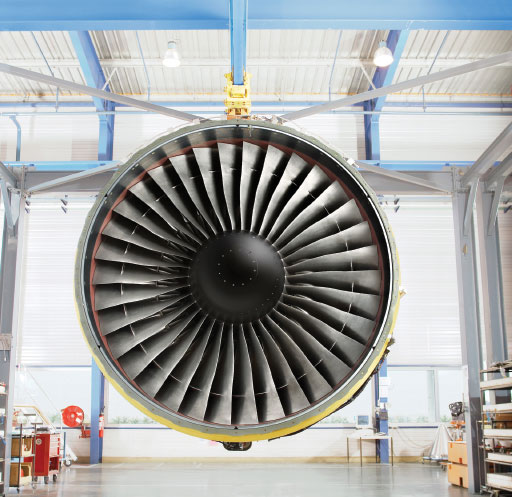
Issues caused by COVID-19 are front-of-mind for this company when asked about maintaining and overhauling widebody engines. “One of the biggest challenges during the pandemic was adapting to meet our customers’ needs virtually when traveling in-person wasn’t possible for engine maintenance training or to provide guidance to airline maintenance technicians on engine inspections,” said Aileen Barton, marketing director for GE Aviation Services. “Before COVID-19, aircraft and jet engine mechanics would travel to one of GE’s or its partners’ training centers for hands-on learning. Due to global travel and social distancing restrictions during the outbreak, more training is being delivered online to where customers are, namely on their laptops and mobile phones.”
This online maintenance training is being provided by GE Aviation’s Customer Technical Education Center (CTEC). As well, GE Aviation’s YouTube channel includes Maintenance Minute video demonstrations. According to Barton, maintenance customers interested in remote and online courses should contact their GE field service engineer or customer support manager.
“A further challenge is keeping global shop capacity and supply chain schedules aligned to meet customer demand throughout the pandemic, during what’s been an unprecedented downturn in the aviation industry,” said Barton. “GE Aviation is taking advantage of this downturn with a renewed focus on Lean principles to help us improve our processes for better customer delivery times, to improve first-time part yield for new and repaired material and to manage more work as the recovery comes.”
Depleted customer cash flow is yet another pandemic problem that is keeping GE Aviation busy. “Widebody engine operators are looking for solutions to preserve cash and maximize flexibility,” Barton noted. “GE Aviation is working with each customer individually to meet their needs.”
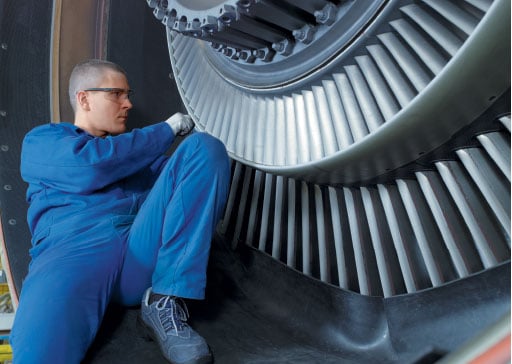
These consultations are being done under the umbrella of GE Aviation’s TrueChoice Services, which gives customers options for maintaining aircraft engines based on their specific (and sometimes unique) operating situations. “These options include TrueChoice Overhaul, as well as alternatives to overhauls,” she said. “Additionally, our open and competitive MRO philosophy provides customers more flexibility while still having access to OEM material, whether GE is servicing the engine or another MRO provider is.”
In the same vein, GE Aviation’s ‘TrueChoice Material’ solutions include new, used and repaired material for widebody engine owners. To provide a selection of lower-priced possibilities, GE Aviation buys in-service GE engines and aircraft with GE engines installed. “These acquisitions provide GE Aviation with an inventory of used serviceable engines and engine parts that are sold to customers and third-party MRO providers,” said Barton. “Meanwhile, Used Serviceable Material (USM) and repaired material can offer GE Aviation customers a way to lower their heavy overhaul costs compared to all-new engine parts, while still maintaining OEM quality standards.”
That’s not all. Widebody aircraft owners can also obtain replacement engines from GE Aviation on short-term operating leases that run up to two years. And because GE Aviation builds the engines it services, the company has the capability to custom assemble engines with a specific amount of remaining flight cycles on rotating life-limited parts and thrust levels. “Custom engine builds are reliable, cost-effective and support each customer’s unique operational needs,” Barton said.
Given the apparent ‘Return to Flight’ crunch that is facing many widebody operators as COVID-19 eases, Aileen Barton recommends contacting your widebody maintenance provider now to book appointments, rather than waiting until later and risking delays in receiving service. “Planning is key,” she advised. “Scheduling needed engine maintenance now while demand for air travel remains slower will prevent constraints across the aviation industry in coming years as flight departures grow back to 2019 traffic levels. Customers are encouraged to provide material orders and schedule shop visits earlier to be more prepared for the recovery.”
MTU Maintenance
Independent MRO MTU Maintenance services General Electric’s CF6-80C2 and GE90-110/115B widebody engines (with full disassembly, assembly and test capabilities) at its facilities in Hannover, Germany and Vancouver, Canada. The Hannover site handles both CF6-80C2 and GE90-110/115B engines, while the Vancouver facility focuses on CF6-80C2s exclusively. As well, as part of GE’s OEM network, MTU Maintenance maintains the turbine center frames (TCF) for the GEnx and the low-pressure turbine (LPT) of the GP7000. The company will be introducing TCF MRO capabilities for the GE9X engine in the near future.
According to Fabien Schoen, director of Programs for MTU Maintenance, there are a number of challenges associated with servicing widebody engines economically. “Generally speaking, these are cost-intensive engines for operators,” he said. “As such, MTU Maintenance offers a wide range of services designed to reduce MRO spend by the absolute maximum across the lifecycle.”
A case in point: For operators of newer widebody engines, the goal is generating more flight hours between maintenance cycles to keep costs down. MTU Maintenance achieves this using ‘intelligent fleet management’ to optimize removals across a defined period, rather than rigid hours-based schedules. “This approach is complemented by predictive maintenance, based on engine trend monitoring, on-site services and spare engine support,” said Schoen. “Once an engine comes into the shop, our customized workscoping, high-tech EASA-FAA approved repairs and our engineering expertise help lower overall costs. We call this program ‘PERFORMPlus’.”
Over time, engines age and the costs associated with servicing them increase. To mitigate this financial sting, MTU Maintenance provides ‘smart strategies for mature engines’. In this vein, “our fully independent solutions include ‘smart repairs’ and tailored workscopes to suit operators’ remaining flight periods as well as material salvation and intelligent teardowns,” Schoen said. “Furthermore, these services can be combined with alternatives to MRO such as leasing in of green-time engines or exchanging engines for the remaining period until phase-out. This service solution goes by the name ‘SAVEPlus’.” As well, MTU Maintenance supports a full range of maintenance contract types including Time and Material and Fly-by-Hour. Customers can also lease replacement engines through the company’s leasing arm MTU Maintenance Lease Services B.V. in Amsterdam, as needed.”
The pandemic affected this MRO as it did everyone else in the aviation industry. “Our CF6 MRO business remained strong throughout the pandemic, due in large part to the continued operations of cargo airlines,” said Schoen. “Generally speaking though for passenger aircraft, narrowbodies have been reactivated first in areas seeing some recovery in air travel. Widebodies have been slow to recover so far and we expect this trend to continue.”
In the context of the COVID-19 cash crunch, MTU Maintenance is predicting a continued trend away from traditional planning with fixed maintenance intervals to more individually-tailored solutions. “Some airlines are concentrating on short-term savings with cash preservation as the main objective, while others are focussing on long-term planning,” Schoen told Aviation Maintenance. “MRO providers must flexibly meet both these goals to provide the best solution for customers in today’s market.”
As for Fabian Schoen’s advice to widebody engine operators wanting to optimize shop visits in the current travel slowdown? He suggests that they discuss their fleet’s requirements with MTU Maintenance to get a maintenance and payment package that works best for them.
“With the tools and measures I have already described, we are able to generate individual and optimized solutions for the specific needs and challenges of our customers,” said Schoen. “We believe it may take a while for the widebody fleet to come back to the pre-covid utilization levels and we can offer tailor-made cost-efficient engine fleet management solutions (e.g., ‘eat-the-fleet’) to minimize cost during such unfortunate periods.”
StandardAero
StandardAero provides maintenance, repair and overhaul (MRO) services for a range of aircraft engines. In the widebody category, they service the Rolls-Royce RB211-535 engine (used in Boeing 757s) at StandardAero’s facility in San Antonio, TX, USA.
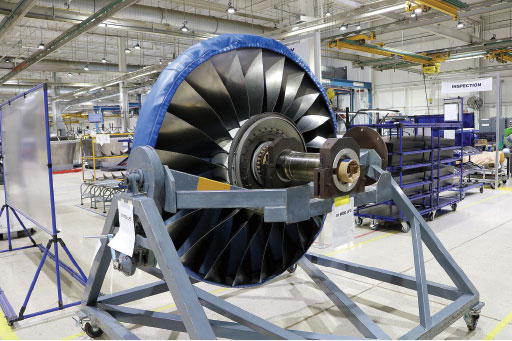
When it comes to getting engines in and out of the shop quickly, “material management is one of the critical factors in delivering responsive turn-around times (TATs) for major repair events,” said Max Allen, Vice President of Commercial Programs RB211 for StandardAero Airlines & Fleets division. “This includes timely new production parts delivery, comprehensive in-house component repair capabilities, and – where appropriate – the utilization of used serviceable material.”
If the parts aren’t available, it doesn’t matter how well trained the company’s technicians are or how advanced a facility’s MRO management software is. Delays will occur.
Achieving an efficient production line for engine repairs is also key to providing timely engine service. “If the line is not appropriately laid out, or not correctly sized, it can delay the overall MRO process, raising TAT times and costs,” Allen said. “Likewise, if an MRO is forced to ship engines to a distant test cell for testing, unnecessary delays can be introduced into the overall process.”
To ensure timely service, StandardAero’s RB211 production line in San Antonio – which is located in the former U.S. Air Force San Antonio Air Logistics Center – was purpose-built from scratch to meet the specific requirements of the RB211 powerplant. This includes having access to an on-site engine test complex with multiple high-thrust test cells to verify performance after repairs
Beyond disrupting the parts supply chain, COVID-19 has added its own twist to RB211-535 maintenance for StandardAero. “On the one hand, the trend of 757s being retired from passenger service has continued and, in the case of a number of operators, accelerated as part of cost reduction efforts in the wake of the pandemic,” said Allen. “On the other hand, the 757’s popularity in the cargo market has continued to grow, as confirmed by the large number of freighter conversions undertaken in 2020 (and the large number scheduled for 2021).”
The 757’s growing role as a freighter is offsetting its retirement from passenger service, and motivating StandardAero to ramp-up its RB211-535 throughput. (The company is in its fourth year as Rolls-Royce’s maintenance service partner on the product.) In fact, given the 757’s strength in the cargo market, StandardAero expects the RB211-535 to provide a steady stream of work for its San Antonio facility for decades to come.
When it comes to paying for RB211-535 repairs, StandardAero offers plans to support both ‘program’ and ‘time and material’ (T&M) customers.
“Program customers are those operators who are enrolled on Rolls-Royce’s TotalCare long-term service agreement,” said Allen. “StandardAero supports these customers as Rolls-Royce’s end-of-life engine maintenance service partner under a partnership signed in 2018.”
While program customers account for the majority of StandardAero’s RB211 throughput, the company does support T&M customers with the same full scope of MRO services. “The majority of our customers already have their own financing solutions in place, but StandardAero is able to assist with lining up third-party financing providers where necessary,” he said.
So, what steps should widebody aircraft operators be taking to get the most from their shop visits? “Probably the best advice that we always give is for operators to plan ahead as far as possible,” Allen replied. “Shop visit slots are booked up months (and, occasionally, years) ahead of schedule, and it is therefore not always possible to accommodate the demands of a customer with critical short-turnaround requirements, regardless of the workscope.”
“As the industry continues to recover after the pandemic, the demand for shop visits has only increased,” he added. “Over the past year a number of maintenance events were deferred for the sake of cost avoidance. Now these engines are starting to be sent for induction as activity resumes and airlines’ cash position improves. As such, engine slots are now in even greater demand, and it will therefore require operators to plan as far ahead as possible when reserving induction slots.”
